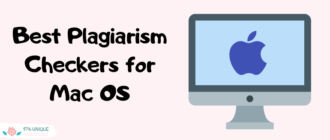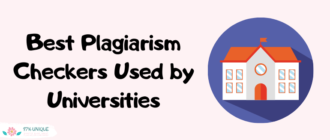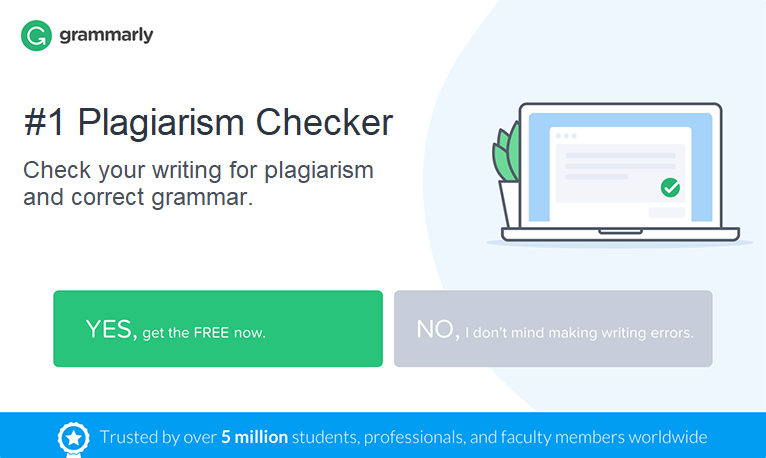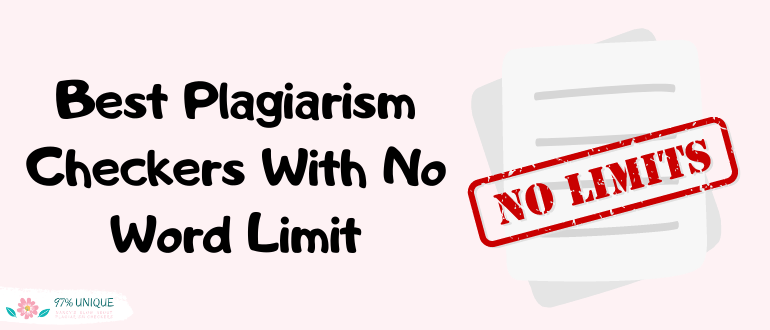
In my many years as a teacher, plagiarism was a frustrating issue that came up on occasion. According to plagiarism.org, in a survey conducted by The Josephson Institute Center for Youth Ethics one in three high school students admitted to using the internet to plagiarize an assignment.
This tells us that plagiarism is a serious problem in our schools. Luckily, there are some great tools out there to help you find out if students are copying from their sources.
After reading this article, you will:
- know the key features of 5 great plagiarism detectors.
- understand how plagiarism checkers can be used in the classroom.
- be able to pick the best product for your classroom at the best price.
While researching this article, I looked at about 34 different plagiarism detectors that promised they could let me know if my students were copying from their sources. I’ve chosen the five best options to tell you about today.
I conducted my research by looking at dozens of different teaching forums to see what other teachers were using. I then dug into each detector’s specifications, looking at the different features, the amount of text you could submit, the different formats of documents they accepted, the size of the database they compared the papers against, and the price.
Take a look at the information below and use it to choose the plagiarism checker that best suits your needs in the classroom!
| Acceptable formats | Features | Price |
|---|---|---|
| 1. Unicheck ↓ | ||
| PDF, Apple Pages, Google Docs, HTML, Excel, PowerPoint, Word, OpenOffice, XML, CSV, MATLAB, Plain Text, Rich Text, and Archives |
|
|
| 2. Turnitin ↓ | ||
| Word, Word Perfect, HTML, Adobe PostScript, Plain Text, Rich Text, ODF, ODT, HWP, PowerPoint, and Google Docs |
|
|
| 3. Plagramme ↓ | ||
| DOC and DOCX |
|
|
| 4. Plagiarism Checker X ↓ | ||
| Microsoft Word Documents (Docx, Doc), RTF, PDF, XLSX, Support, and Plain Text |
|
|
| 5. Noplag ↓ | ||
| DOC, DOXC, RTF, TXT, ODT, HTML, and PDF
. |
|
|
As a veteran teacher, I know what kinds of papers my students usually submit for assignments and how I’ve caught plagiarism in the past, so I was able to weed out the plagiarism detectors that wouldn’t provide the features that I would need in my own classroom and focus on the ones with the best options.
1. Unicheck

Features: Unicheck’s plagiarism checker provides a detailed report within minutes to help you identify and correct plagiarism, offering suggesting solutions for identified issues. It also identifies and flags suspicious text formatting and other digital trickery that tech-savvy students might employ to get away with plagiarized content.
Database size: It has a digital library of over 91 billion sources to check against, and users can add student papers to its library to ensure students aren’t copying from each other.
Word Limit: You can upload text of any length to the Unicheck server.
Price: It costs $15 to check 100 pages of text.
Accepted formats: PDF, Apple Pages, Google Docs, HTML, Excel, PowerPoint, Word, OpenOffice, XML, CSV, MATLAB, Plain Text, Rich Text, and Archives.

Pros: There are many great things about Unicheck: users love its clean interface and intuitive menus. It also offers a Google add-on, so you can check for plagiarism on the go. It can be integrated with most learning management systems and is free from viruses and other security threats. The formatting of uploaded text will not be altered while the plagiarism report is being generated, so your results will be clean. While the reports generated are intuitive and easy to understand, you can also access 24/7 user support.
Cons: Some users dislike the pay-per-page structure that the personal plan offers. However, professionals can get quotes for different pricing structures. Other users report that some major websites are missing from Unicheck’s database and that the site functions poorly on mobile devices.
The biggest problem I’ve faced as a teacher has been plagiarism. This video can help your students learn how to avoid plagiarizing their sources while writing a paper.
2. Turnitin
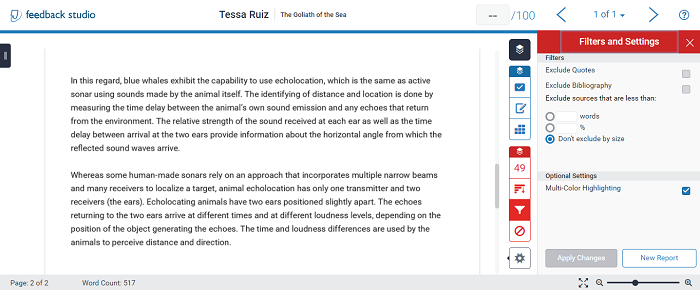
Features: Turnitin is the program most frequently used by colleges and universities. Each student submits their paper to the plagiarism checker before submitting their assignment. Turnitin will then supply a report giving the student a percentage of plagiarized text and suggestions for improving the originality of the text.
Database Size: Papers are checked against a database of 200 million student papers, 17 billion web pages, and 90,000 journals, periodicals, and books.
Cost: The school pays $2-3 per student
Word Limit: You can upload a document of up to 400 pages in length.
Acceptable formats: Word, Word Perfect, HTML, Adobe PostScript, Plain Text, Rich Text, ODF, ODT, HWP, PowerPoint, and Google Docs.
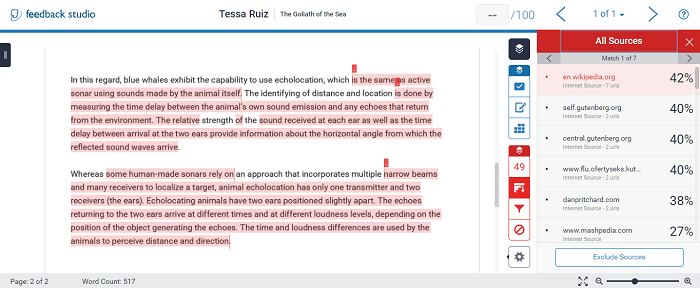
Pros: One of the biggest assets to Turnitin is its reputation in the academic community. With so many teachers and professors using it, more student papers are being added to the database all the time. The database is large and extremely thorough. Turnitin can easily integrate with various learning management systems, so it’s easy for teachers to use. Teachers can also add their own rubrics, making the feedback more personalized. Users state that the results are easy to navigate and very user-friendly. The website also regularly shares other resources for teachers that can be invaluable for a great classroom experience.
Cons: According to some users, one drawback of Turnitin is the stability of the site’s connection; some students report losing their work when the website crashes. Other users cite the high price for large classes as a significant drawback, as well as the difficulty using the site on mobile devices.
3. Plagramme
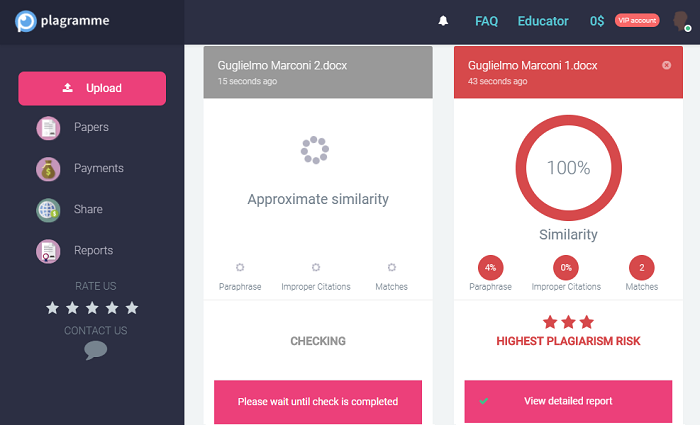
Features: The checker provides a plagiarized percentage, highlights the copied text, and even gives you a link to the source that the text was copied from so you can see for yourself exactly where the student got the information. Plagramme can also detect questionable paraphrases, improper citations, and text in over 120 languages.
Database Size: Plagramme checks student papers against its database of over 80 million scholarly articles to check for plagiarism.
Price: It’s free for educators to use the free version, and you can pay $5 per document for premium features.
Page Limit: There is no limit for the length of the documents that you can submit to Plagramme.
Acceptable formats: .doc and .docx.

Pros: One great benefit to Plagramme is its lack of a page or word limit; you can check papers of any length without a problem. The free option for educators also makes the program very accessible to any teacher with a computer and internet access. The reports are available very quickly, so you won’t need to wait around for results if you have a lot of student papers to check.
Cons: One significant drawback to Plagramme is the limited number of file types supported by the checker. In addition, some users report that the free version does not check a sufficient number of sources to really screen for plagiarism, but that the premium option does a better job.
Even if you teach students how to avoid plagiarism, some of them will still turn in a paper that has been copied from a source. This video talks about what happens when a student gets caught plagiarizing.
I’ve used a lot of web-based tools that you can use to help make my own writing better; they can check for plagiarism and even make sure that your grammar is on point. You can read about some of the best ones here.
4. Plagiarism Checker X
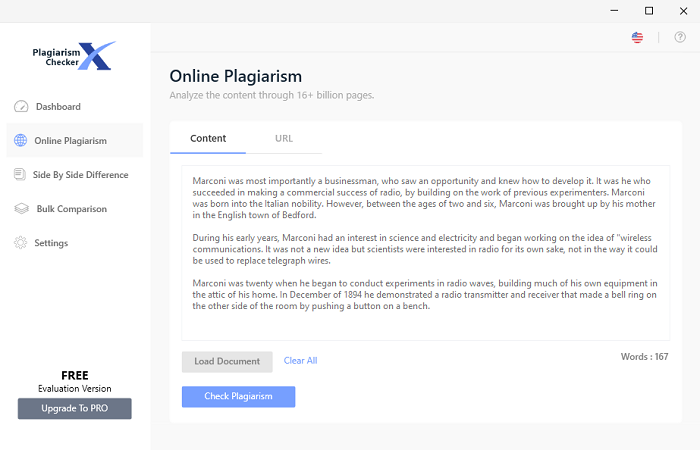
Features: Plagiarism Checker X is another great low-cost option. Teachers can upload student papers, and it checks over 16 billion sources and provides a report detailing the similarities between the paper and these sources. Results are available quickly; Plagiarism Checker X can analyze 20,000 words per second, that is why it’s on my list of the best plagiarism checkers with no word limit. When viewing the results report, you can view the paper side-by-side with the plagiarized source to closely examine the similarities between the two texts.
Cost: There is a basic version available for free, and the Professional version costs $39.95 per license.
Database Size: Over 16 billion sources
Word Limit: Plagiarism Checker X has no size limit for documents.
Acceptable formats: Microsoft Word Documents (Docx, Doc), RTF, PDF, XLSX, Support, and Plain Text.
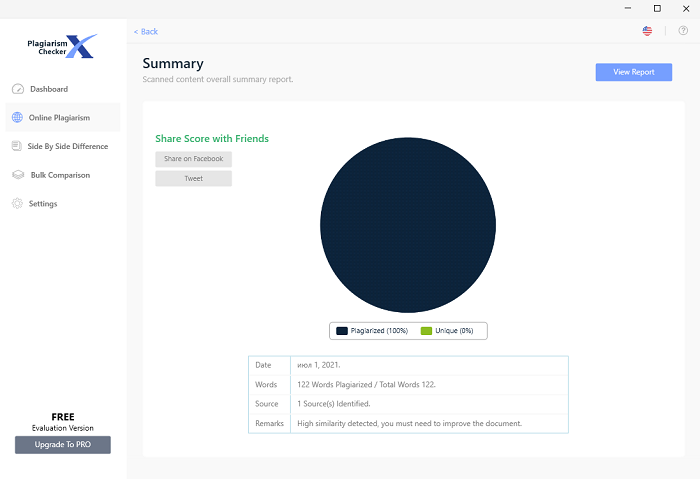
Pros: Teachers love being able to upload and check student papers in bulk. This makes checking many papers in one go fast and convenient. Plagiarism Checker X is also very secure, so you know that the data you upload won’t be stored or leaked in any way. It is also very cost-effective, as a license is good for a lifetime and requires no renewal. Reports are detailed and color-coded, making them user-friendly and easy to interpret. It also has a massive database, so you can be certain that the results you get are accurate.
Cons: This particular checker does not offer a mobile version, which was a disappointment for some users. Some users also state that longer papers can take a while to scan despite the site’s promise of a fast turnaround time. Although this program has a huge database, it still isn’t as large as some more well-known options like Turnitin.
Getting caught plagiarizing a paper is a scary thing for a student. The advice in this video can help them prepare for an academic dishonesty hearing.
A bigger struggle may come with helping students with their writing. You can read here about how to help them write a great literature review.
5. Noplag
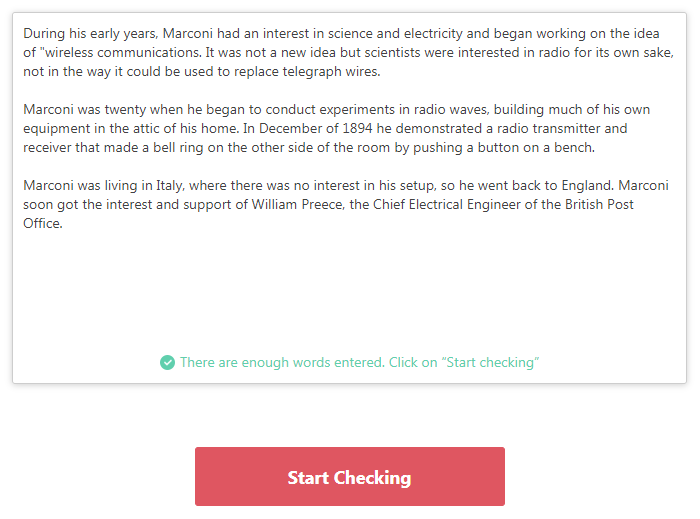
Features: Noplag is a simple-to-use option, I often recommend it for students who need help with their writing. In addition to checking for plagiarism, it also provides writing assistance, helping you format your writing, proofread it, and write your citations. Noplag has a database consisting of 5 billion web pages, 100 million publications, and 20 million papers, articles, and journals, so you can be assured that papers submitted to this site are well-checked for plagiarized content. The cost varies depending on the plan you choose.
Cost: The starter package is $72 per year and the premium is $108 per year. You can also pay $1 per paper.
Database Size: 5 billion web pages, 100 million publications, and 20 million papers, articles, and journals
Word Limit: Noplag has no limit to the number of words or pages you can submit.
Acceptable formats: doc, .docx, .rtf, .txt, .odt, .html, and .pdf.
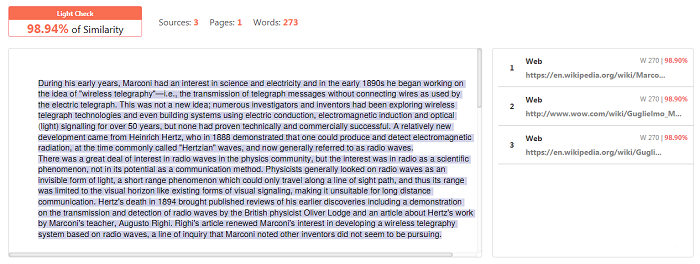
Pros: This plagiarism detector is entirely web-based, so it works quickly. The report that it generates is detailed and provides links to any sources that appear to be plagiarized, making comparison easy. It also allows you to build a library of your previously submitted papers; this option is great for students who are worried about losing their work on unreliable computers. You can also use this to check that you haven’t plagiarized yourself. Noplag also offers a bulk upload option for teaches, so you can check multiple student submissions at the same time.
Cons: Some users state that the price of Noplag is high compared to other, similar options. Others dislike the fact that it is entirely web-based, as a poor internet connection can cause delays. Some users have also experienced difficulties when submitting PDF documents.
Useful Resources
- What is plagiarism?
- Is recycling your own work plagiarism?
- Consequences of plagiarism for students, academics, and professionals
- Global Plagiarism – understanding the problem
Conclusion
Plagiarism can be one of the trickiest and most frustrating parts of the teaching profession that’s why I recommend these plagiarism checkers with no word limit. Hopefully, students can avoid plagiarism before turning in their papers.
Here, read about plagiarism checkers that students can use that show what percentage of their text matches source materials. With these tools and your guidance, hopefully, your students can nip plagiarism in the bud!


